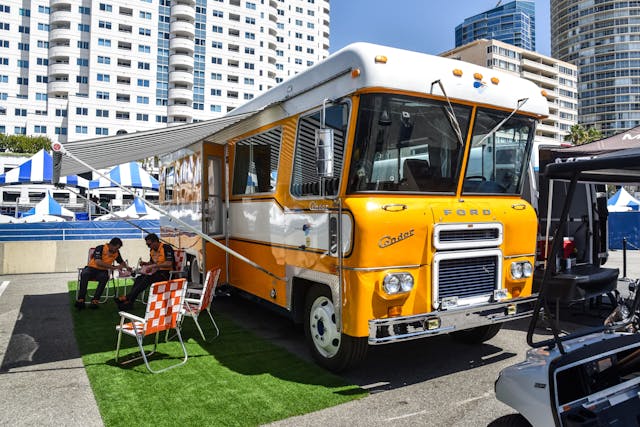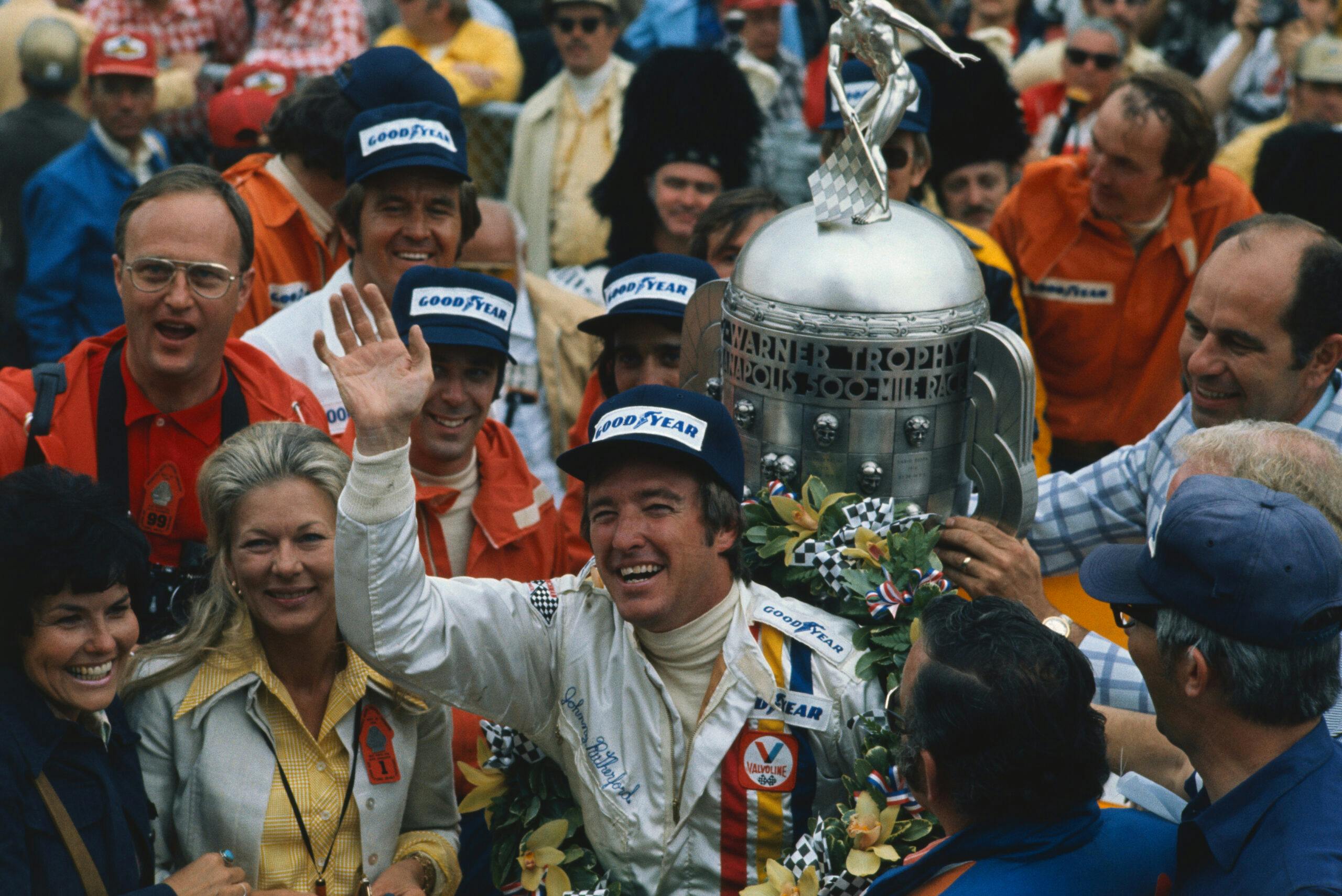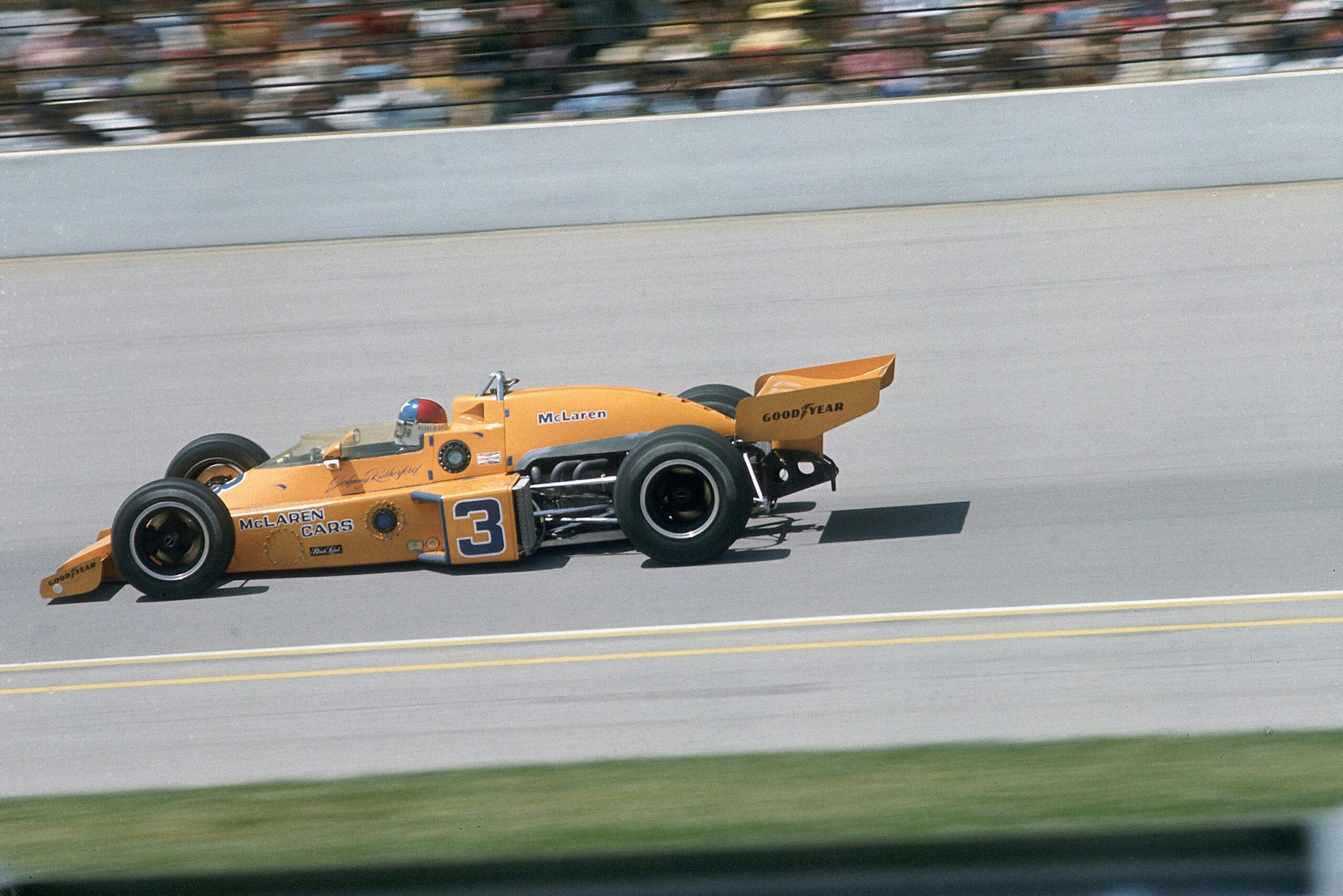The real story behind McLaren boss Zak Brown’s retro RV
Scott Timberlake was driving a rental car to watch his son play in a Little League tournament game in Cooperstown, New York, when he spotted an ancient, orange motorhome mounted on ramps in a used-car lot. The steep incline made it look like the RV was going to pop a wheelie onto State Highway 28.
“All these old Granadas and LTDs and Camaros were sitting there, and here’s this big thing with its front end up in the air,” Timberlake says, thinking back to that day in 2005. “I’m a car guy, and I’m naturally curious, and I’d never seen anything like it. So I was intrigued.”
On the way back from the game, he saw it again. And again the next morning. And again that evening. Finally, Timberlake—an ad sales manager for car magazines and a lifelong racing fan—couldn’t restrain himself. He swerved onto the shoulder, hit his flashers, and dashed across the highway for a closer look. What he found led him on a 15-year odyssey down a rabbit hole of motorsports history.
There was a sign on the colossal windshield: “1972 Condor. Sleeps eight. McLaren motorcoach. USAC, Formula 1, Can-Am.” On the bodywork were a bunch of tattered McLaren Cars decals. That’s when Timberlake realized that the motorhome wasn’t merely orange. It was papaya—the distinctive color that the McLaren team started using in 1968.

“Oh, my god,” he thought. “Oh, my gawd!”
Then he spotted another sign on the windshield: “Sold.” And he thought, “Shit!”
But by this point, Timberlake was too jazzed to just walk away. He marched into the dealership, spoke to the staff, and discovered that the Condor had just been bought by the chef-owner of a nearby seafood restaurant called the Yum Yum Shack. When he got back in his rental car, he told his wife, “I feel like seafood.”
Over dinner at the Yum Yum Shack, Timberlake met the new owner of the motorhome and asked him to call if he ever decided to sell the Condor. When the baseball tournament ended, Timberlake returned home to Southern California, and his fantasy of buying a motorsports icon evaporated.
A few months later, his cell phone rang.
“It’s Dave from the Yum Yum Shack in New York. With the Condor. I just want to you know I’m gonna get rid of the damn thing, and you told me to give you first crack.”
For Timberlake, this was a be-careful-what-you-wish-for moment. “I stayed up until two or three in the morning with a friend of mine talking about the pros and cons—how this could jeopardize my marriage, how I don’t need a motorhome. I don’t even want a motorhome. I’ve never owned a truck, let alone a RV. Our neighborhood doesn’t allow boats or motorhomes, so I can’t just park it in front of the house or beside the house. What am I going to do with it? My friend goes, ‘So don’t do it.’ And I say, ‘Dude. I’m just a normal guy, and I’m having a brush with motorsports history. I don’t have a choice. If I don’t do this, I will always kick myself.’”
Even though Timberlake figured a plain-Jane ’72 Condor II was worth about $3,000, he agreed to pay $22,000 because of the totally unconfirmed McLaren heritage. Besides driving a hard bargain, Dave from the Yum Yum Shack also informed Timberlake that he had to do something with the motorhome pronto because it was November, and in upstate New York that meant a freeze was imminent.
Timberlake flew east the next weekend. Although he’d never driven a motorhome before, he was determined to flog it to a family Thanksgiving gathering in Chicago. Without checking the tires or fluid levels, he cranked the starter and threw the sucker into gear …
… and ran smack into a blizzard.

It was so cold inside the cabin that he was wearing blankets, gloves, and a beanie. The storm was blowing so ferociously that he could barely see out the panoramic windshield. Of course, he couldn’t have gone very fast even if he’d wanted to because the 13,000-pound motorhome was being motivated by a two-barrel, 390-cubic-inch Ford V-8—essentially the same engine that had been found in a 3600-pound 1972 Mustang GT.
Climbing the long grade up to the Chicago Skyway, Timberlake lost momentum. He was crawling along at 10 miles per hour in low gear and praying the Condor would make it to the top of the bridge when the engine died. Fearing disaster, he shifted into Neutral and rolled backward, dead-stick, down the bridge until reaching level ground. He had to pay $1,900, in cash, to get the motorhome towed to the family get-together in Chicago.
Timberlake didn’t have time to drive back to Southern California, so he found a storage facility and split. It wasn’t until the next summer that he returned to collect the Condor. This time, he ran into a heat wave instead of a blizzard, and he had to endure an endless weekend in Tulsa while locating a replacement water pump before following Route 66 to Los Angeles.
Once he got the Condor back home, he didn’t restore it or use it as a conventional motorhome. When he parked it in a campground, he didn’t bother hooking up the water or electricity or using the toilet. Instead, treated the orange leviathan like a huge mobile hangout at baseball games and surf events up and down the West Coast.

To friends and family, the Condor was nothing more than a beloved party wagon. But Timberlake still thought of it as a priceless motorsports artifact. He just couldn’t prove it. Inside the motorhome, he’d found race programs, promotional McLaren material, and time sheets from the 1978 F1 race at Watkins Glen, where James Hunt and Patrick Tambay drove McLaren M26s. This hardly constituted definitive evidence.
“A lot of my friends thought I was out of my fricking mind,” he admits. “They’d go, ‘Yeah, and you probably think that Monte Carlo going down Hawthorne Boulevard was Dale Earnhardt’s because it had a 3 on the side.’”
Over the years, Timberlake showed photos of the motorhome to old racers like Mario Andretti and Roger Penske, but none of them recognized it. Looking back, he could have tried harder to run down some more information. But he didn’t. Maybe, subconsciously, he preferred to leave his questions unanswered. Better a fanciful myth than the tawdry truth that he’d vastly overpaid for a papaya elephant.
Fast forward to 2016. Timberlake was browsing through the art in the Randy Owens booth at the Long Beach Grand Prix. While examining a print of Johnny Rutherford crossing the finish line to win the 1974 Indy 500 in a McLaren M16C, he heard a voice behind him say, with a hint of a Texas twang, “I remember that.”
When Timberlake turned around, he confronted none other than Lone Star J.R. himself. Timberlake whipped out his phone and showed Rutherford a photo of his mystery motorhome. Rutherford laughed and told him, “That’s Bill Smith’s Condor. I’ll be goddamned.”
Like most people, Timberlake had no idea who Bill Smith was. A little bit of research unearthed a little-known figure with a spectacularly forgettable name who’d played an indelible but largely unheralded role in McLaren history.
A former Ford executive who later owned Ford dealerships, Smith was a successful club racer with international aspirations. Through his association with Teddy Mayer, a confidante of Bruce McLaren’s, Smith was present at the creation of McLaren Motor Racing in 1963. He was later a director of Team McLaren and the founder of McLaren Engines. As the president of McLaren North America, he oversaw the Indy car program in USAC and the BMW team in IMSA. Later still, he was a founding member of the open-wheel series CART.
Timberlake found Smith living in. . . wait for it. . . Cooperstown, New York.
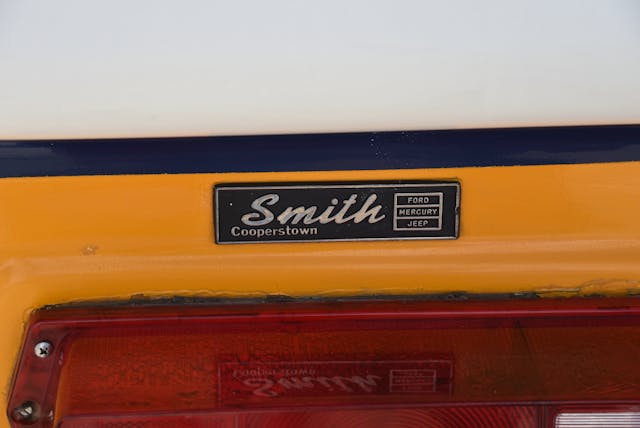
Over the phone, Smith explained that, in 1973, he’d decided to bring a motorhome to USAC races. Today, paddocks and parking lots at pro races are filled with million-dollar motorhomes and hospitality lounges where teams, drivers, VIPs, and journalists can make deals, conduct interviews, and just plain chill. Back in the 1970s, though, big-time corporate sponsorship was just getting off the ground, and the paddock accommodations were threadbare at even the most prestigious events.
A big thinker and close friend to fellow ideator Roger Penske, Smith planned to change that. Instead of a gussied-up camper, he wanted a full-size, high-end motorhome to show the McLaren flag. Considering his long association with Ford, the 1972 Condor II was a natural choice since it was built on a Ford truck chassis and was equipped with a Ford engine. (Movie fans may recall that this model was featured in National Lampoon’s Christmas Vacation.)
The motorhome Smith ordered was 28 feet long, with ample room to sleep eight. It was outfitted with captain’s chairs, green carpeting, wood paneling, a CB radio, and an 8-track tape deck. It also came with an ingenious, perhaps somewhat creepy, Thermasan Waste Destruction System, which supposedly eliminated sewage by incinerating it with heat from the exhaust manifold.
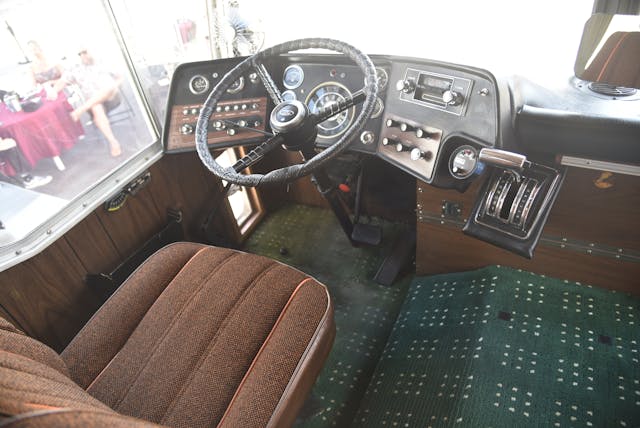
The Condor II was a mainstay in the McLaren paddock at races in North America through the 1970s. Smith continued to own it until it was sold to the owner of the Yum Yum Shack. When Timberlake bought it, it was in marginal shape, and after 15 years of family vacations, the motorhome was nearing its sell-by date. In 2020, Timberlake reluctantly decided to get rid of it.
“It wasn’t about the money,” he insists. “I just wanted it to find a suitable home.”
Timberlake approached museums, high-bucks collectors, and, ultimately, McLaren itself. There were no takers. Even when he offered to donate the motorhome for free, he got nowhere. Finally, as a last resort, he listed it for auction with no reserve on Bring a Trailer.
Thanks to the McLaren connection, the BaT community went a little bit crazy. Later, it would be honored as the BaT Success Story of the Year. All told, there were 181 comments. For the record, a certain segment of them missed the point. “I got a lot of people who asked me, ‘You think I could tow with it up to Lake Shasta?’ or ‘Would it do good going to Midland, Texas, with a trailer?’” Timberlake recalls. “I told them, ‘No! No, it’s not good at anything. Nothing works on it. It barely starts, and it barely stops. It’s a hotel room with no running water, no air, and no refrigerator.”
After spirited bidding, the Condor sold for $32,500. It turned out that the winning bidder was a beard for Zak Brown, the American marketing maven who now runs McLaren Racing. This revelation generated plenty of news, and some cynics intimated that Timberlake had been snookered by the subterfuge. Timberlake has absolutely no regrets.

After refurbishing the motorhome, Brown put the Condor where it belongs. Rather than displaying it in a museum or squirreling it away in a climate-controlled storage facility, Brown showcases it in the paddocks of select IndyCar and F1 races. His guests have included team members, VIPs, journalists, and a now-retired ad exec named Scott Timberlake.
“It took a special person to appreciate this vehicle, and I couldn’t have found anybody more appropriate than the CEO of McLaren Racing,” Timberlake says. “Zak Brown adding it to his remarkable collection is a fitting end to this chapter of the story.”
A half-century after being put into service and driven from coast to coast, the Condor’s journey has ended right back where it started: trackside under the care of a McLaren boss.
***
Check out the Hagerty Media homepage so you don’t miss a single story, or better yet, bookmark it. To get our best stories delivered right to your inbox, subscribe to our newsletters.
Via Imola
